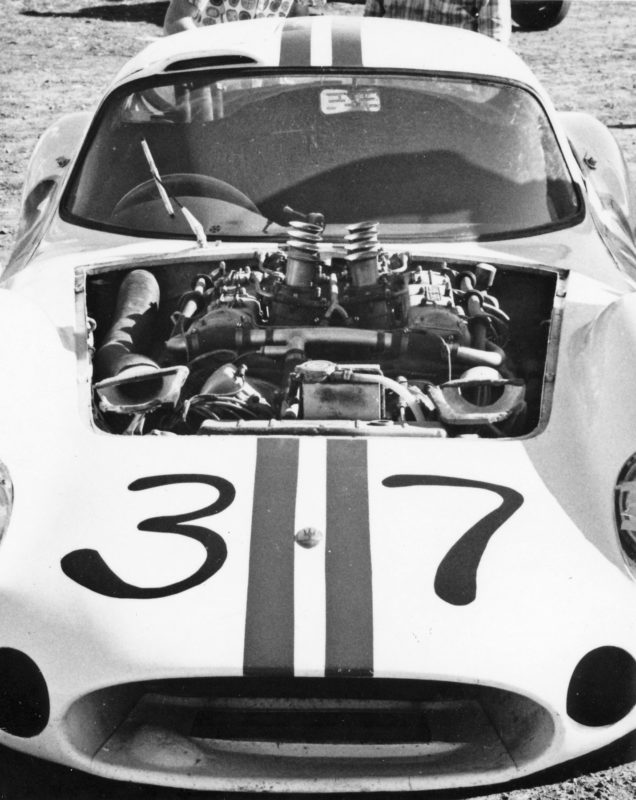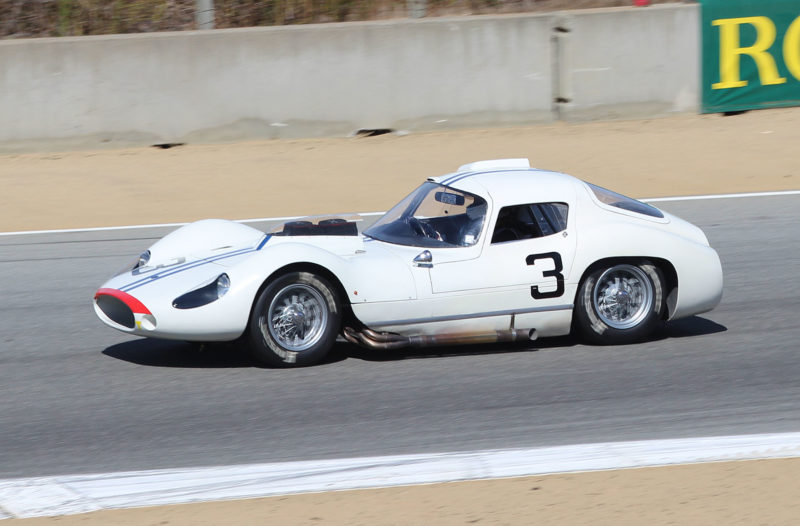Notes from the Archives: Maserati Tipo 151
May 25, 2017
By Gary Horstkorta
On September 10, 1962, barely four months after the conclusion of the 24 Hours of Le Mans, one of the cars from that race sat in the paddock at Vaca Valley Raceway waiting for the beginning of a Divisional race. The car was a Maserati Tipo 151 enter by well known Bay Area car dealer Bev Spencer. This was not just another race car but a special car, a former Briggs Cunningham team car.
Cunningham had been a regular competitor at Le Mans beginning in the 1950’s originally with a pair of Cadillacs athen progressing through a series of his own designed race cars. Coming close but not quite on the podium he contracted with the Maserati factory to build two special coupes for the 1962 race. The cars, designated Tip0 151 with sn. 004 and 006 were front engine models with powerful 4-liter, 4 cam, 350hp V-8s providing plenty of power for the 24 Hour race. Unfortunately, 006 driven by Jim Kimberly and Dr. Dick Thompson was retired after five hours as a result of failing brakes and 004, five hours later with a failed suspension.

4 Liter, 4 cam, 350hp, V-8 engine, a brute
After the car was repaired, Cunningham entered it in races at Elkhart Lake and Bridgehampton race with Augie Pabst at the wheel finishing third and a DNF respectively. Next race was at Riverside for the LA Times Grand Prix where the car finished seventh. After the race the car was sold to Bev Spencer, the first of several cars he would campaign for the next several years. For the Vaca Valley race, Spencer hired local hot shoe, Stan Peterson to drive the car. Upon inspecting the car, Peterson was skeptical of the cars chances based his assessment of the cars design.
Despite Peterson’s misgivings about the car, he was in the middle of the front row at race time. On his right was the new Corvette Z06 driven by Paul Rheinhart and on his left, Dan Gillum’s Maserati 150S, both good drivers. Also in the field were Merle Brennan in his Jaguar D-type/Chevy and the Ferrari/Chevy of Bill Sherwood. At the green flag, Brennan shot to the front from the second row with Peterson right on his tail. The positions remained the same as the crossed the S/F line to begin lap two.
As they approached the turn one right hander, Peterson drifted wide into the marbles, then onto the grass and rolled the Maserati. Whether this development was due to a mechanical issue or Peterson’s lack of any practice time in the car was up for discussion. Fortunately, the car landed in a muddy area which absorbed much of the impact of the crash minimizing the damage but ruined the cars debut in the SFR.

Reinhart, Peterson, Gillum on the front row at Vaca Valley
With primarily cosmetic damage, Peterson repaired it in his Oakland speed shop and two weeks after the Vacaville event, the car appeared in the San Francisco Imported Car Show. In December, the Tipo 151 had a brief on-screen appearance in a short movie called “This is Laguna Seca” directed by SFR photographer Bill Hewitt. Shortly thereafter, the car was advertised for sale in Road & Track magazine for $7,950. It was purchased by Southern Californian drag race team owner Chuck Jones who wanted to go road racing.
Chuck Jones entered it under his Team Meridian banner for driver Skip Hudson at Cotati – where Hudson drove it with the doors removed finishing third. Jones then advertised it for sale in the July 27, 1963, edition of ‘Competition Press’, asking $8,250. In the absence of attractive offers for the car, it was then driven solo by Hudson in the Road America ‘500’ officially finishing 17th. Briggs Cunningham was so impressed by Hudson’s effort he gave the team his remaining stock of Maserati 151 components, including three spare V8 engines, two gearboxes and the burned-out wreckage of ‘004’ – which was subsequently buried in a landfill site near Newport Beach. Jones retired the Maserati, painted it red and registered it as a California street car. Two years later, he sold the Maserati to a San Francisco resident for cash and a Lincoln Continental.

Fifty-three years later, Tipo 151 at Rolex Monterey Motorsports Reunion
The car was held in private hands until 1983, when Maserati enthusiast, Peter Kaus, purchased the car and returned it to its original Cunningham colors to display it in his Rosso-Bianco museum in Aschaffenburg, Germany. In 2006 the Maserati was sold to Lawrence Auriana, who undertook a full restoration to make it race-worthy once again. The car was entered in that year’s Rolex Monterey Motorsports Reunion and driven by Derek Hill. It was subsequently raced at the Goodwood Festival of Speed and then sold to an American collector at auction for a reported $1.5 million at the end of 2006. And to think, had you been around in 1962, you could have bought this car for less than $8,000!
